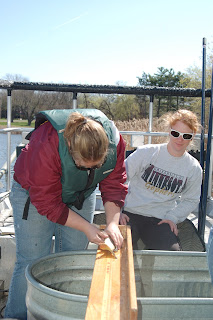Casey Lake Update - Winter 2013
Partners: Local citizens, City of North St. Paul, U of MN, DNR, and the RWMWD
By: Bill Bartodziej
 |
| U of MN researchers measuring a carp caught via electrofishing. |
Over the last five years, the common carp population in Casey Lake has been studied in great detail. We learned that Casey supported an extremely high biomass (weight) of carp, estimated at over 500 pounds per acre. Carp biomass above 100 pounds per acre is considered detrimental to lakes. Last year, a lot of effort was invested into reducing the carp population in Casey. In terms of management, this is important for two reasons. First off, Casey can be thought of as a carp nursery area for the entire Phalen Chain of Lakes. We have learned that fish in Casey can move down the watershed during high water conditions and populate other lakes. Secondly, it is very plausible that the high numbers of carp in Casey is linked to poor water quality. Without carp, there is a good chance that Casey will experience better water quality and a more balanced ecological system.
|
Activity
|
Number harvested
|
Total weight estimate
(lbs)
|
|
February - netting (10’x50’ open water area)
|
1,617
|
1,446
|
|
March - Dead fish collection from shore (ice out)
|
900
|
2,250
|
|
April - Commercial netting (entire lake)
|
189
|
50
|
|
Summer electro-fishing and other
|
327
|
435
|
|
July - Box netting (baited trap)
|
142
|
189
|
|
|
|
|
|
TOTALS=
|
3,175
|
4,370
|
In November 2012, Casey’s water level was lowered by opening a valve in the lake’s outlet pipe. This water level draw down was done in order to make repairs to the outlet pipe. As a result of previous maintenance work, the pipe settled at an angle and needed to be modified slightly. The outlet pipe valve will be closed in late February of this year. Casey’s water level will remain at or near its current elevation until the spring of 2013, where snowmelt and spring rains will naturally refill the lake.
A side benefit of lowering the lake’s water level is that it allows the lake water to freeze almost entirely, and thereby greatly reducing the amount of water that carp typically use to survive through the winter. Lake level drawdowns are sometimes used as a fish management tool. Last month, watershed staff drilled over 100 holes in the ice to monitor water depth on Casey (see map below). Drilling was concentrated in deeper areas of the lake where water pockets may exist.
 |
| The map indicates points on Casey Lake where holes were drilled in the ice to look for open pockets of water where carp may be surviving the winter. |
This year’s drawdown resulted in a very effective reduction of water in this system. We detected small (< 25 sq. ft.) pockets of water in several locations, but water depth was less than a few inches. We did not see any evidence of fish, of any species, taking refuge in these pockets of water. Additionally, the U of MN research team located four radio-tagged carp in four separate areas of the lake (skull and crossbones on map above). These fish were frozen in the ice sheet.
 |
| RWMWD intern Tracy augering a hole on Casey. She found seven inches of ice and saturated, muddy lake bottom substrate underneath. |
These findings suggest that this year’s water level drawdown, coupled with normal winter temperatures, resulted in very minimal open water refuge areas for carp. Watershed staff and the U of MN research team are optimistic that a majority of carp in this system will not survive through the winter. If a lot of carp wash up on shore after ice-out, the Watershed will assemble a cleanup team. An electro-fishing survey in spring will determine if any carp did somehow make it through these extremely tough conditions.
In December 2012, the City of North St. Paul passed a resolution supporting the management of Casey Lake. The council voted unanimously to move forward with the management approach that was outlined in the council workshop by the U of MN carp research team and Watershed staff (December 4th, 2012). The following is a summary of the plan which was covered in the resolution:
Casey Management Plan Outline – 2013
- Water level drawdown to adjust outlet pipe – in progress, RWMWD
- Carp treatment – January or February – (Note: not necessary due to the lack of an open water refuge)
- Spring carp survey to determine treatment effectiveness – U of MN
- If deemed effective, DNR will stock bluegill this spring.
- Aeration system installation – late summer/fall – DNR, City, RWMWD
- If carp numbers are found to be high in spring, then a piscicide (a substance used to kill fish) will be considered for a fall, 2013 treatment. Bluegill stocking would then be postponed until spring 2014.
- All parties will continue communication at each step of the management process.
Soon after ice-out, the U of MN research team and Watershed staff will be electro-fishing Casey in search of the common carp. Please stay tuned this spring for a full report of our results and other findings!



Thanks for all your hard work in cleaning up Casey.
ReplyDeleteLinda Olson
Way to go! Can't wait for a cleaner lake Gervais to wakeboard and swim in. All these efforts help.
ReplyDeleteIt sounds like a successful project. Looking forward to getting the next progress report.
ReplyDelete